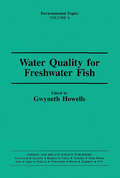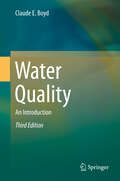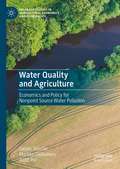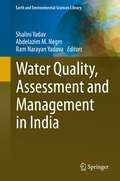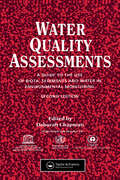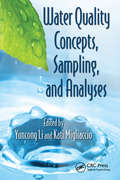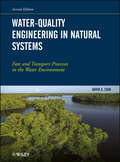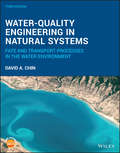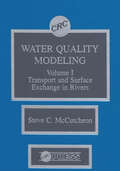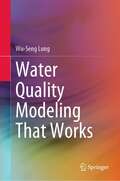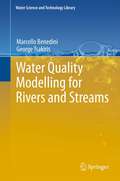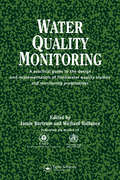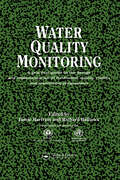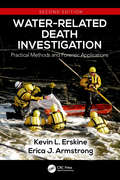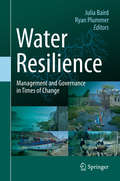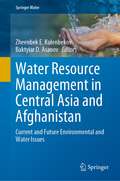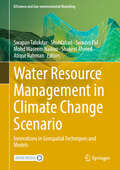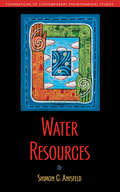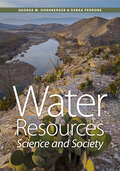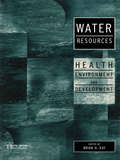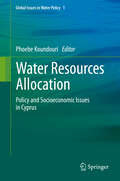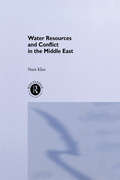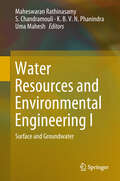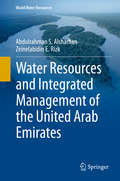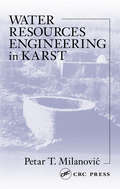- Table View
- List View
Water Qual Freshwater Fish
by Gwyneth HowellsThis book covers the major polluting chemicals affecting fisheries in European fresh waters and the effort required to extend the work towards the preparation of critical reviews on less important chemicals would be out of proportion to the benefits obtained.
Water Quality: An Introduction (Aquaculture Ser.)
by Claude E. BoydThis volume is of great importance to humans and other living organisms. The study of water quality draws information from a variety of disciplines including chemistry, biology, mathematics, physics, engineering, and resource management.University training in water quality is often limited to specialized courses in engineering, ecology, and fisheries curricula. This book also offers a basic understanding of water quality to professionals who are not formally trained in the subject.The revised third edition updates and expands the discussion, and incorporates additional figures and illustrative problems. Improvements include a new chapter on basic chemistry, a more comprehensive chapter on hydrology, and an updated chapter on regulations and standards.Because it employs only first-year college-level chemistry and very basic physics, the book is well-suited as the foundation for a general introductory course in water quality. It is equally useful as a guide for self-study and an in-depth resource for general readers.
Water Quality and Agriculture: Economics and Policy for Nonpoint Source Water Pollution (Palgrave Studies in Agricultural Economics and Food Policy)
by James Shortle Markku Ollikainen Antti IhoWater pollution control has been a top environmental policy priority of the world’s most developed countries for decades, and the focus of significant regulation and public and private spending. Yet, significant water quality problems remain, and trends for some pollutants are in the wrong direction. This book addresses the economics of water pollution control and water pollution control policy in agriculture, with an aim towards providing students, environmental policy analysts, and other environmental professionals with economic concepts and tools essential to understanding the problem and crafting solutions that can be effective and efficient. The book will also examine existing policies and proposed reforms in the developed world. Although this book addresses and has a general applicability to major water pollutants from agriculture (e.g., pesticides, pharmaceuticals, sediments, nutrients), it will focus on the sediment and nutrient pollution problem. The economic and scientific foundations for pollution management are best developed for these pollutants, and they are currently the top priorities of policy makers. Accordingly, the authors provide both highly salient and informative cases for developing concepts and methods of general applicability, with high profile examples such as the Chesapeake Bay, Lake Erie, and the Gulf of Mexico Dead Zone in the US; the Baltic Sea in Northern Europe; and Lake Taupo in New Zealand.
Water Quality, Assessment and Management in India (Earth and Environmental Sciences Library)
by Shalini Yadav Abdelazim M. Negm Ram Narayan YadavaThis book presents up-to-date information on the status of water resources in India. It presents an assessment of the surface water and groundwater condition to help stakeholders take the necessary actions to control pollution and make the country’s water resources sustainable. The book addresses various topics, including forest-water interactions for governing water quality at catchment scales, water quality status, rainwater harvesting methods, acid-mine drainage, water pollution, management strategies, drinking water quality, and treatment of industrial wastewater. Given its scope, the book offers a valuable tool for policy planners who wish to improve the current situation and move toward sustainable water resources in India.
Water Quality Assessments: A guide to the use of biota, sediments and water in environmental monitoring, Second Edition
by Deborah ChapmanThis guidebook, now thoroughly updated and revised in its second edition, gives comprehensive advice on the designing and setting up of monitoring programmes for the purpose of providing valid data for water quality assessments in all types of freshwater bodies. It is clearly and concisely written in order to provide the essential information for all agencies and individuals responsible for the water quality.
Water Quality Concepts, Sampling, and Analyses
by Yuncong Li Kati MigliaccioAs water quality becomes a leading concern for people and ecosystems worldwide, it must be properly assessed in order to protect water resources for current and future generations. Water Quality Concepts, Sampling, and Analyses supplies practical information for planning, conducting, or evaluating water quality monitoring programs. It presents the
Water-Quality Engineering in Natural Systems: Fate and Transport Processes in the Water Environment
by David A. ChinProvides the tools needed to control and remediate the quality of natural water systems Now in its Second Edition, this acclaimed text sets forth core concepts and principles that govern the fate and transport of contaminants in water, giving environmental and civil engineers and students a full set of tools to design systems that effectively control and remediate the quality of natural waters. Readers will find coverage of all major classes of water bodies. Moreover, the author discusses the terrestrial fate and transport of contaminants in watersheds, underscoring the link between terrestrial loadings and water pollution. Water-Quality Engineering in Natural Systems begins with an introduction exploring the sources of water pollution and the control of water pollution. It then presents the fundamentals of fate and transport, including the derivation and application of the advection–diffusion equation. Next, the text covers issues that are unique to: Rivers and streams Groundwater Watersheds Lakes and reservoirs Wetlands Oceans and estuaries The final two chapters are dedicated to analyzing water-quality measurements and modeling water quality. This Second Edition is thoroughly updated based on the latest findings, practices, and standards. In particular, readers will find new methods for calculating total maximum daily loads for river contaminants, with specific examples detailing the fate and transport of bacteria, a pressing problem throughout the world. With end-of-chapter problems and plenty of worked examples, Water-Quality Engineering in Natural Systems enables readers to not only understand what happens to contaminants in water, but also design systems to protect people from toxic pollutants.
Water-Quality Engineering in Natural Systems: Fate and Transport Processes in the Water Environment
by David A. ChinThis textbook describes in detail the fundamental equations that govern the fate and transport of contaminants in the environment, and covers the application of these equations to engineering design and environmental impact analysis relating to contaminant discharges into rivers, lakes, wetlands, groundwater, and oceans. The third edition provides numerous end-of-chapter problems and an expanded solutions manual. Also introduced in this edition are PowerPoints slides for all chapters so that instructors have a ready-made course. Key distinguishing features of this book include: detailed coverage of the science behind water-quality regulations, state-of-the-art methods for calculating total maximum daily loads (TMDLs) for the remediation of impaired waters, modeling and control of nutrient levels in lakes and reservoirs, design of constructed treatment wetlands, design of groundwater remediation systems, design of ocean outfalls, control of oil spills in the ocean, and the design of systems to control the quality of surface runoff from watersheds into their receiving waters. In addition, the entire book is updated to provide the latest advances in the field of water-quality control. For example, concepts such as mixing zones are expanded to include physical nature and regulatory importance of mixing zones, practical aspects of outfall and diffuser design are also included, specific details of water-quality modeling are updated to reflect the latest developments on this topic, and new findings relating to priority and emerging pollutants are added.
Water Quality Modeling: River Transport and Surface Exchange, Volume I
by Steven C. McCutcheonThis fascinating work is divided into two main sections. Part I reviews the basic principles of water movement in channels and the mass balance approach common to most models. It also covers the practical usefulness, model peer review, and guidance on model selection and calibration. Part II discusses flow simulation and prediction of time of travel, dye tracing and mixing, heat balance and temperature modeling, and reaeration and volatilization. This interesting, easy-to-read volume includes comprehensive reviews for the use of fluorescent water tracing dyes, longitudinal dispersion, evaporation and wind speed functions, prediction of saturation concentrations of dissolved oxygen, and reaeration coefficients. This book furnishes the reader with appendices which provide a synopsis of available computer models and gives a comprehensive listing of methods used to measure flow rates in rivers, tributaries, and pipes and channels introducing wastewaters into streams. This volume is a valuable, indispensable reference for all researchers, instructors, students in advanced environmental modeling courses, and practicing engineers.
Water Quality Modeling That Works
by Wu-Seng LungThis book offers a practical guidance for environmental engineers and scientists charged with assessing the cause-and-effect of pollutants in receiving water systems. Instead of blindly running models, which is a practice seen too often in today’s field that can result in results with uncertainty, modelers must first understand the physical insights of the specific water systems in order to properly calibrate the parameters of the models. This book reinforces the critical importance of properly understanding the physical attributes of water systems by drawing on the author’s extensive experience in modeling with strong data support. This is also what sets this book apart from the volumes currently available in the water quality modeling field – nearly all other books in the field are categorized as textbooks, and unlike this book, offer few practical examples or exercises to follow. Environmental engineers and scientists engaged in quantifying the water quality impacts of pollutants to specific water systems will find this book valuable in their day-to-day practices. This book is a necessary volume for water quality engineers and scientists to consult for the regulatory planning and management of water systems
Water Quality Modelling for Rivers and Streams
by George Tsakiris Marcello BenediniThe main objective of the Water Framework Directive in the European countries is to achieve a "good status" of all the water bodies, in the integrated management of river basins. In order to assess the impact of improvement measures, water quality models are necessary. During the previous decades the progress in computer technology and computational methods has supported the development of advanced mathematical models for pollutant transport in rivers and streams. This book is intended to provide the fundamental knowledge needed for a deeper understanding of these models and the development of new ones, which will fulfil future quality requirements in water resources management. This book focuses on the fundamentals of computational techniques required in water quality modelling. Advection, dispersion and concentrated sources or sinks of contaminants lead to the formulation of the fundamental differential equation of pollutant transport. Its integration, according to appropriate initial and boundary conditions and with the knowledge of the velocity field, allows for pollutant behaviour to be assessed in the entire water body. An analytical integration is convenient only in one-dimensional approach with considerable simplification. Integration in the numerical field is useful for taking into account particular aspects of water body and pollutants. To ensure their reliability, the models require accurate calibration and validation, based on proper data, taken from direct measurements. In addition, sensitivity and uncertainty analysis are also of utmost importance. All the above items are discussed in detail in the 21 chapters of the book, which is written in a didactic form for professionals and students.
Water Quality Monitoring: A practical guide to the design and implementation of freshwater quality studies and monitoring programmes
by Jamie Bartram Richard BallanceWater quality monitoring is an essential tool in the management of water resources and this book comprehensively covers the entire monitoring operation.This important text is the outcome of a collborative programme of activity between UNEP and WHO with inputs from WMO and UNESCO and draws on the international standards of the International Organization of Standardization.
Water Quality Monitoring: A Practical Guide to the Design and Implementation of Freshwater Quality Studies and Monitoring Programmes
by Jamie Bartram Richard BallanceWater quality monitoring is a fundamental tool in the management of freshwater resources, and this book covers the entire monitoring process providing detailed guidance for implementing a monitoring network with step-by-step descriptions of field and laboratory methods.
Water-Related Death Investigation: Practical Methods and Forensic Applications
by Kevin L. Erskine Erica J. ArmstrongNearly ten years after the first edition of Water-Related Death Investigation: Practical Methods and Forensic Applications, water death cases continue to be improperly investigated. The pathologist’s report can determine the cause of death as a drowning, but the manner of death is the most challenging to prove. The report will not determine if a victim jumped into the water to commit suicide, fell into the water accidentally, or was pushed in as a homicidal act. Many drowning cases do not reflect injury to the body, so evidence collected at the scene plays a vital role. The importance of an on-scene body assessment cannot be overemphasized. Often, the body evidence begins to change rapidly upon recovery and may not be present during an autopsy. Written statements on the scene are an effective tool to use to determine the accuracy of information given to arriving officers. These statements need to be written by the witnesses themselves as well as the reporting person. The "Show Me" technique can also help reveal discrepancies in a person’s version of what occurred as well as aid in providing the most details to an incident as is humanly possible. This second edition includes updated information on the latest technology to assist water death investigators. Parabon Snapshot can help determine the faceless identity of skeletal remains and help locate potential suspects using the science of DNA. Drones can aid in locating missing persons as well as human remains, even months after death. Updated information is provided regarding fingerprints from submerged objects, and Carbon-14 can help determine the origin of a found corpse. Key Features: Thoroughly reviews the physiological aspects of drowning Reveals the investigative characteristics inherent to various scenes of water-related deaths Highlights certain "red flag" indicators that may point to foul play or scene staging Outlines autopsy protocols, trial preparation, and expert witness testimony Provides numerous case studies and numerous illustrations to further clarify key points presented in the text Coauthored by a Master Water Death Investigator and an experienced forensic pathologist, Water-Related Death Investigation: Practical Methods and Forensic Applications, Second Edition merges the essentials of evidence collection and field investigation with autopsy best practices and laboratory testing. It will continue to serve as a valuable resource for the various professionals involved in these cases.
Water Resilience: Management and Governance in Times of Change
by Julia Baird Ryan PlummerThis book synthesizes current knowledge and understanding of management and governance in the context of water resilience; advances theory through synthesis of research and experiences from a variety of disciplinary perspectives. The book highlights the implications of theory and experience for innovation in practice and policy; and it explores frontiers and future research. The book further addresses the need for a consolidated, interdisciplinary approach to the theoretical advances and practical implications of water resilience for academics, resource managers, aid organizations, policy makers and citizens.
Water Resource Management in Central Asia and Afghanistan: Current and Future Environmental and Water Issues (Springer Water)
by Zheenbek E. Kulenbekov Baktyiar D. AsanovThe book provides a cross-sectoral, multi-scale assessment of development-directed investigations in the main rivers of wider Central Asia and Afghanistan. The book highlights the development of river systems, water reservoirs, ecosystems and risks as well as the impact of climate change on water resources in Central Asian countries and Afghanistan. It provides information on the genesis of river basins, physical and chemical properties of water in rivers, and the hydrological regimes of the rivers of Central Asia and Afghanistan. The book is useful for scientists and researchers whose work focuses on rivers and the use of water resources, irrigation, ecosystems, risks, water supply, climate change and remote sensing, as well as for students and planners, administrations and other stakeholders in the water sector.
Water Resource Management in Climate Change Scenario: Innovations in Geospatial Techniques and Models (GIScience and Geo-environmental Modelling)
by Shakeel Ahmed Atiqur Rahman Swapan Talukdar Shahfahad Swades Pal Mohd Waseem NaikooThis book seeks to showcase the ongoing challenges of water resource and its management through innovative and cutting-edge approaches (flooding and droughts and their respective impacts; spatial and urban planning; early warning systems; estimation of losses; water resource in the age of global climate change; risk communication; meteorology; integrated analysis; risk mitigation; infrastructures; nature-based management; watershed management; transport; legal assessment; vulnerability analysis; public participation; or case studies). In the face of current global changes, the availability and quality of water resources are under severe threat. Indeed, in all sectors related to water resource management, sustainable development is important for present and future generations. Indeed, multiple problems such as water shortage or flooding, as well as environmental pollution phenomena, are observed. This situation is further exacerbated by poor management practices and unsustainable extraction of water for various consumptive uses. Consequently, many regions around the world, particularly urban areas, are becoming water stressed and conflicts over access to water are becoming ever more common. To overcome the significant challenges fundamental to the management of water resources, cutting-edge knowledge, innovative approaches, and an in-depth understanding of the inherent scientific, economic, social, and environmental issues are imperative. Therefore, water resource management requires a clear understanding of the ongoing challenges and innovative approaches. The authors and editors believe that this book provides huge knowledge and data in the fields of water resource management, earth environmental sciences, humanities, and social sciences, which target a diverse range of readers, such as academics, scientists, students, environmentalists, meteorologists, urban planners, remote sensing, and GIS experts.
Water Resources (Foundations Contemporary Environmental)
by Shimon C. AnisfeldIn this concise introduction to water resources, Shimon Anisfeld explores the fundamental interactions between humans and water, including drinking, sanitation, irrigation, and power production. The book familiarizes students with the current water crisis and with approaches for managing this essential resource more effectively in a time of rapid environmental and social change. Anisfeld addresses both human and ecological problems, including scarcity, pollution, disease, flooding, conflicts over water, and degradation of aquatic ecosystems. In addition to providing the background necessary to understand each of these problems, the book discusses ways to move towards better management and addresses the key current debates in the water policy field. In the past, water development has often proceeded in a single-sector fashion, with each group of users implementing its own plans without coordination with other groups, resulting in both conflict and inefficiency. Now, Anisfeld writes, the challenge of water management is figuring out how to balance all the different demands for water, from sanitation to energy generation to ecosystem protection. For inquiring students of any level, Water Resources provides a comprehensive one-volume guide to a complex but vital field of study.
Water Resources: Science and Society
by George M. Hornberger Debra PerroneA scientifically rigorous text grounded in socioeconomic reality that examines both physical hydrology and contemporary water usage issues.The fair allocation and wise use of fresh water presents significant challenges across the world. To avoid unresolvable crises in the future, judiciously managing water resources in the twenty-first century is fundamentally important. Integrating the underlying science of hydrology with real-world usage scenarios, Water Resources offers a nuanced, modern treatment of contemporary water resource management issues.In this ground-breaking new text, renowned environmental scientist and educator George M. Hornberger and award-winning environmental engineer Debra Perrone examine the role of water resources in natural, social, and human-built systems, helping students understand and evaluate the complex tradeoffs required to achieve sustainable water management. Providing a much-needed educational tool that looks at freshwater resources within the context of the crucial water-energy-food nexus, the text • includes a primer on the elements of physical hydrology necessary to understand resource availability; • covers rivers, lakes, groundwater, and soil water;• relates water to agriculture, energy, urbanization, and the environment;• highlights connections between water quantity and quality; • explains the economic and legal constraints around water resources; • considers the impacts of climate change and population growth; and• proposes paths forward for the sustainable use of water.Teaching basic methods used to make informed water management decisions, the book includes illustrative quantitative calculations, qualitative think-pieces, and case studies. An appendix provides a review of units, dimensions, and conversions useful for addressing each chapter's example problems. Online answer keys are also available.Positioned to become the foremost text on water resource issues, this companion to Hornberger's widely regarded Elements of Physical Hydrology reveals the enormity of the water crisis facing the planet while offering realistic hope.
Water Resources: Health, Environment and Development
by Brian H. KayThis collection addresses the complexities of water management and the impact of environmental developments such as dams, reservoirs and irrigation schemes on public health.The main focus of the book is on vector-borne diseases such as malaria, arboviruses (dengue and encephalitides) and snail- borne schistosomiasis. These are examined from a wide
Water Resources Allocation
by Phoebe KoundouriThe dilemma facing Cyprus--that of limited water supplies (both in terms of quantity and quality) in the face of steadily increasing water demand, coupled with a fragmented institutional structure of the water sector--is characteristic of most arid and semi-arid countries all over the world. Another common characteristic of Cyprus is that the water management administrative boundaries there do not coincide with the hydrological ones, while the ongoing political problem of the island creates significant administration problems.
Water Resources and Conflict in the Middle East
by Nurit KliotThe Middle East is a region of international concern and political unrest. This book forms a complete reference to both the hydrological as well as the social, economic, political and legal issues in the region and shows how water shortages threaten the renewal of military conflicts and disruption in the area. With resources over-extended due to natural and human causes, the book analyses the river basins of the Euphrates, Tigris, Nile and Jordan and provides detailed study of the hydrology, hydrography and geography of these river basins; it also analyses the needs of the economies and societies of the countries bordering these basins. Conclusions on likely areas of conflict are set within the legal framework of the Helsinki and International Law Commission Rules.
Water Resources and Environmental Engineering I: Surface And Groundwater
by K.B.V.N. Phanindra Uma Mahesh S. Chandramouli Maheswaran RathinasamyThe book is a compilation of the papers presented in the International Conference on Emerging Trends in Water Resources and Environmental Engineering (ETWREE 2017). The high quality papers are written by research scholars and academicians of prestigious institutes across India. The book discusses the challenges of water management due to misuse or abuse of water resources and the ever mounting challenges on use, reuse and conservation of water. It also discusses issues of water resources such as water quantity, quality, management and planning for the benefits of water resource scientists, faculties, policy makers, stake holders working in the water resources planning and management. The research content discussed in the book will be helpful for engineers to solve practical day to day problems related to water and environmental engineering.
Water Resources and Integrated Management of the United Arab Emirates (World Water Resources #3)
by Abdulrahman S. Alsharhan Zeinelabidin E. RizkThis book provides an inventory of water resources, describes water challenges, and suggests methodologies and technologies for integrated water resources management in the UAE. It also summarizes efforts of water conservation and management, and modern approaches for improvement of water resources management and decision-making related to this valuable resource. The authors are specialized in geology and hydrogeology and have been teaching and conducting scientific research on water resources in the UAE for the last three decades. This book represents the main reference on water resources in the UAE for academia, researchers, professionals, students and the general public.
Water Resources Engineering in Karst
by Petar MilanovicA definitive guide, this book focuses on the design and construction of water infrastructure projects within karst formations and provides engineering approaches for preventing and mitigating their environmental problems. It features 200 figures, investigative techniques, practical design solutions, case studies with failure analysis, criteria prop
